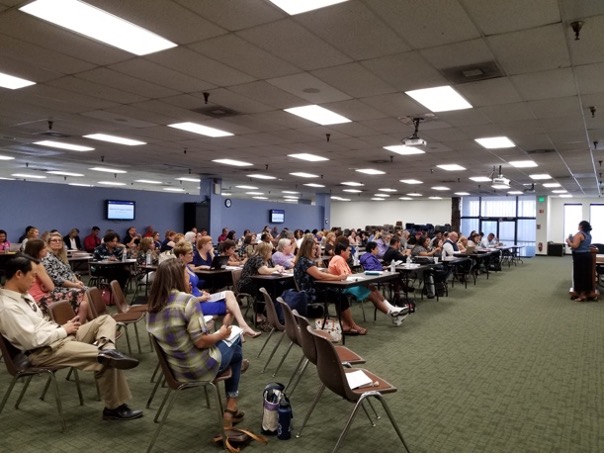Aligning Super-Consortia Professional Development Through a Collective Impact Model for Social Change
Submitted By: Veronica Parker
AEBG Staff/Partner
Website: https://icec.sbcusd.com/cms/One.aspx?portalId=73544&pageId=3277694
Type of Practice: Learner Transition
Program Area(s): ABE / ASE, ESL / EL Civics / Citizenship, CTE / Workforce Prep / Pre-apprenticeship, Adults with Disabilities, K12 Success
Region: Inland Empire
Consortia Involved: San Bernardino Community College District Consortium
Program Overview
To meet the regional need of comprehensive and rigorous professional development, Inland Adult Education Consortium took the lead as the convening agency for the entire region, not just the five consortia operating in the county, but inclusive of consortia as far away as San Diego and Los Angeles. Doing so helped to level-set the knowledge, skills, and expectations of classified staff, certificated teachers, and administrators.
The Program of Practice
San Bernardino County consists of more than 20,000 square miles. The vast distance between CAEP programs created a need for more regional professional development, as site-based trainings were simply not feasible. During the AEBG phase, professional development was offered only at sites several hours away from the more rural areas of the county and at locations outside San Bernardino.
The Response
To meet the regional need of comprehensive and rigorous professional development, Inland Adult Education Consortium took the lead as the convening agency for the entire region, not just the five consortia operating in the county, but inclusive of consortia as far away as San Diego and Los Angeles. Doing so helped to level-set the knowledge, skills, and expectations of classified staff, certificated teachers, and administrators.
To address the comprehensive need of all CAEP funded programs, IAEC implemented a Regional Professional Day in 2016. IAEC divided the region need into two categories: State Trainings and Professional Development. State Trainings included hosting representatives from the Chancellors Office/CDE and CASAS twice annually to fully train participants from across the Inland Empire and beyond. State Trainings also included hosting the Google Summit. These training events draw participants from as far north as Bakersfield, east to Blythe, west to Los Angeles, and south to San Diego.
The Annual Professional Development Day takes place prior to the start of the school year. This day is divided into its own categories: trainings from curriculum/assessment providers, presentations from community partner organizations such as the workforce development board and immigration services, presentations from instructional practitioners on best-practices, and themes that align to the CAEP State Priorities. This annual event draws participants from across Southern California with attendance often exceeding 150 participants. Both of these types of events continued virtually through the pandemic, as the outcomes realized at participating sites from previous years demonstrated the need to continue.
The Unique Features of the Program
One key aspect of both the regional training days and the professional development days is the structured and facilitated time allocated for program area networking. It is often the case that people work in isolation, whereas there might be only one counselor at an adult school who rarely has the opportunity to share and discuss ideas with colleagues from other sites. By incorporating structured (with guided questions) and facilitated (with a trained facilitator) time into the events, ad hoc PLCs are formed resulting in shared ideas, a spirit of collaboration, and a collective impact model of success.
The Outcome
Professional Development and Training is a key component of the CAEP State Priorities. By structuring both of these events to align with regional need, IAEC is providing rigorous, relevant, and actionable information on topics that increase student retention and performance outcomes, while targeting the WIOA consideration of qualified instructors and staff.

